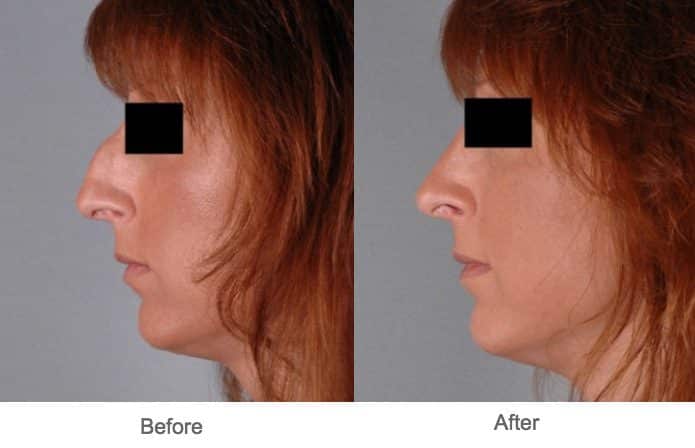The Best Strategy To Use For Rhinoplasty Surgery Austin Tx
Table of ContentsThe Single Strategy To Use For Rhinoplasty Surgery AustinThe 5-Second Trick For Nose JobExamine This Report about Austin Rhinoplasty
Picture 4. Nasal hump excision: The black delineation shows the desired nose-reduction result: a straight nose. The nasal hump is bone (red) above the scalloped grey line, and cartilage (blue) below the scalloped grey line. The cosmetic surgeon cuts the cartilage part of the bulge with a scalpel, and chisels the bone part with an osteotome (bone sculpt).Rhinoplastic instruments: Bone-scraping rasps, of numerous grades and types, that the cosmetic surgeon utilizes to refine the corrections needed to produce a new nose. In plastic surgical praxis, the term main rhinoplasty represents an initial (first-time) reconstructive, functional, or visual restorative treatment. The term secondary nose surgery represents the revision of a failed nose job, an occurrence in 520 percent of rhinoplasty operations, hence a modification nose surgery.
Although a lot of revision nose job procedures are "open technique", such a correction is more technically complicated, usually since the nasal support structures either were warped or ruined in the primary nose surgery; therefore the cosmetic surgeon must re-create the nasal assistance with cartilage grafts collected either from the ear (auricular cartilage graft) or from the chest (costal cartilage graft).
In reconstructive rhinoplasty, the defects and defects that the plastic surgeon encounters, and should bring back to typical function, kind, and appearance consist of broken and displaced nasal bones; interfered with and displaced nasal cartilages; a collapsed bridge of the nose; hereditary problem, injury (blunt, permeating, blast), autoimmune disorder, cancer, intranasal drug-abuse damages, and stopped working primary rhinoplasty outcomes.
When cartilage is interfered with, suturing for re-suspension (structural assistance), or using cartilage grafts to camouflage a depression allow the re-establishment of the typical nasal shape of the nose for the client. When the bridge of the nose is collapsed, rib-cartilage, ear-cartilage, or cranial-bone grafts can be used to restore its anatomic stability, and thus the visual continuity of the nose.

The 2-Minute Rule for Rhinoplasty Surgery Austin
Surgically, the borders of the nasal subunits are perfect areas for the scars, whereby is produced a superior visual result, a fixed nose with matching skin colors and skin textures. Nasal skeleton For that reason, the successful rhinoplastic result depends entirely upon the respective upkeep or repair of the structural stability of the nasal skeleton, which makes up (a) the nasal bones and the ascending procedures of the maxilla in the upper third; (b) the paired upper-lateral cartilages in the middle third; and (c) the lower-lateral, alar cartilages in the lower 3rd (austin rhinoplasty surgery).
The paired alar cartilages set up a tripod-shaped union that supports the lower third of the nose. The paired medial crura adhere the central-leg of the tripod, which is connected to the anterior nasal spinal column and septum, in the midline. The lateral crura make up the second-leg and the third-leg of the tripod, and are attached to the (pear-shaped) pyriform aperture, the nasal-cavity opening at the front of the skull.
the nasal lining A thin layer of vascular mucosa that adheres firmly to the deep surface of the bones and the cartilages of the nose. Said thick adherence to the nasal interior limits the mobility of the mucosa, as a result, just the smallest of mucosal defects (< 5 mm) can be sutured primarily.

Moreover, concerning scarrification, when compared to find more information the skin of other facial areas, the skin of the nose produces fine-line scars that generally are unnoticeable, which permits the surgeon to tactically hide the surgical scars. Principles The technical principles for the surgical restoration of a nose originate from the vital personnel principles of cosmetic surgery: that the used procedure and technique( s) yield the most acceptable practical and visual outcome.
However, the physician-surgeon and the rhinoplasty patient should abide the reality that the rebuilded nasal subunit is not a nose appropriate, however a collagen- glued collageof forehead skin, cheek skin, mucosa, vestibular lining, nasal septum, and pieces of ear cartilagewhich is viewed as a nose only due to the fact that its shape, skin color, and skin texture are real to the initial nose - austin Get More Information rhinoplasty surgery.
Rhinoplasty Surgery Austin Things To Know Before You Get This
1. 0 metre). Yet, such an aesthetic result suggests the application of a more complicated surgical method, which requires that the cosmetic surgeon balance the patient's required rhinoplasty, with the client's visual suitable (body image). In the context of surgically reconstructing the patient's physiognomy, the "regular nose" is the three-dimensional (3-D) design template for replacing the missing out on part( s) of a nose (aesthetic nasal subunit, visual nasal sector), which the plastic surgeon re-creates utilizing company, malleable, modelling materialssuch as bone, cartilage, and flaps of skin and of tissue.
To effect an overall nasal reconstruction, the design template may derive from quotidian observations of the "normal nose" and from photographs of the client before she or he suffered the nasal damage (rhinoplasty austin tx). The cosmetic surgeon replaces missing out on parts with tissue of like quality and quantity; nasal lining with mucosa, cartilage with cartilage, bone with bone, and skin with skin that best match the native skin color and skin texture of the harmed nasal subunit.
Moreover, regardless of its significant scarring tendency, the nasal skin flap is the prime factor to consider for nasal reconstruction, because of its greater verisimilitude. The most effective nasal reconstruction for repairing a problem (injury) of the nasal skin, is to re-create the entire nasal subunit; thus, the wound is bigger to understand the whole nasal subunit.